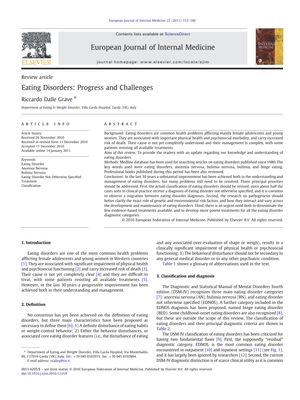Eating Disorders: Progress and Challenges
January 2011
in “
European Journal of Internal Medicine
”

TLDR Despite progress, better treatments and understanding are needed for the high rates of long-term issues and deaths linked to eating disorders.
The document from 2011 provides an overview of the state of knowledge and treatment of eating disorders, focusing on anorexia nervosa (AN), bulimia nervosa (BN), and eating disorder not otherwise specified (EDNOS), as well as the newly recognized binge eating disorder (BED). It reports that eating disorders are common among female adolescents and young women in Western countries, with AN and BN having a lifetime prevalence of approximately 0.6% and 1%, respectively, and BED around 3%. The document criticizes the DSM-IV classification for its limitations, particularly the overuse of EDNOS and suggests a transdiagnostic approach to diagnosis. It also notes that genetic factors account for 50-83% of the variance in these disorders, with environmental and psychological factors also playing significant roles. The document highlights the physical and psychiatric comorbidities associated with eating disorders and the need for more effective treatments. It mentions that the UK's NICE guidelines have improved treatment approaches, with family-based treatment for AN in young people and cognitive-behavioral therapy for BN and BED being the most supported. However, it concludes that despite some progress, challenges remain, including the need for better treatments and understanding of the high rates of chronicity and mortality associated with these disorders.